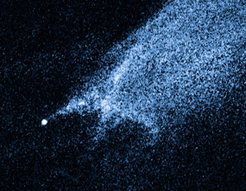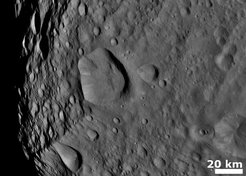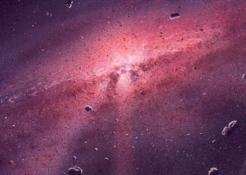Small bodies and comets: Research
Archived page
Composition of Asteroids, Comets, Transneptunian Objects (TNOs)

The chemical, isotopic, and mineralogical composition of asteroids, comets, and Transneptunian objects (TNOs) provides clues to the history of individual bodies, the formation and evolution of the solar system, the possible origin of Earth’s water, and the presence of organic compounds. We measure the composition with both remote sensing and in-situ instruments. Remote sensing methods study the light emitted from and/or reflected by a body. The spectral properties of the light carry signatures that are specific to the material at the surface of a body or in its atmosphere. Remote sensing instruments are cameras and spectrometers sensitive in different wavelength regimes from UV to the submillimetre. They can be mounted on spacecraft that fly to individual bodies (e.g. the comet mission Rosetta, the asteroid mission Dawn), on space-based telescopes (e.g. the Herschel Space Telescope, operating at far-infrared and sub-millimetre wavelengths), or on ground-based telescopes. Complementary to the remote sensing measurements are the in-situ instruments, which directly analyse material collected at the object. Prominent techniques used at MPS are mass-spectroscopy to analyse dust and gas from a comet (Rosetta/COSIMA, Rosetta/ROSINA, Rosetta/COSAC), and gas chromatography (Rosetta/COSAC).
People involved:
Hermann Boehnhardt, Chaitanya Giri, Fred Goesmann, Paul Hartogh, Martin Hilchenbach, Martin Hoffmann, Christopher Jarchow, Klaus Jockers, Harald Krüger, Urs Mall, Nafiseh Masoumzadeh, Andreas Nathues, Nilda Oklay, Miriam Rengel, Reinhard Roll, Juan Andres Sanchez, Holger Sierks, Colin Snodgrass, Harald Steininger, Guneshwar Singh Thangjam, Cecilia Tubiana
Physics of cometary activity

Some of the minor bodies in the solar system display activity, releasing volatile and refractory material (gas and dust) to their environment. Most active bodies are comets, which orbit the Sun on distinctly elliptical orbits. Comets are often described as “dirty snowballs” because they are composed of frozen volatiles (ice) and solid material (dust). Their activity is driven by the sublimation of volatiles that occurs when the comet approaches the Sun. The gas released due to the sublimation carries the dust in its flow. The Rosetta mission to comet 67P/Churyumov-Gerasimenko will provide us with unprecedented insights into the physical processes underlying the activity of a comet, because for the first time a spacecraft will stay in the close vicinity of the comet for an extended period (two years), and a lander will touch down on the surface. We will be able to link the gas, dust and plasma surrounding the comet to its regions of origin on the surface, and to study the physical properties of these regions (e.g. temperature, composition, morphology, constitution) in great detail. To put the Rosetta findings into a solar system context, we observe both the Rosetta target and a wider sample of comets with ground-based telescopes. Dedicated modelling of the dust dynamics allows us to link the dust observed on relatively coarse scales from Earth to the processes taking place at the surface of the comet.

A more recently discovered class of active small bodies is that of the “Main Belt Comets” (MBCs), which are also referred to as “activated asteroids”. These are objects on asteroidal (low-eccentricity) orbits that release dust at least transiently. Unlike in “normal” comets on elliptical orbits, this activity cannot be due to increased solar radiation on approach to the Sun. Possible activation mechanisms include the exposure of previously hidden reservoirs of volatiles, collisions between asteroids, and rotation-induced breakup. MBCs are currently observed with Earth- and space-based telescopes. To discriminate between the different activation mechanisms, dynamical modelling of the ejected dust is an important tool.
People involved:
Jessica Agarwal, Hermann Boehnhardt, Klaus Jockers, Harald Krüger, Holger Sierks, Colin Snodgrass, Peter Strub, Cecilia Tubiana, Jean-Baptiste Vincent
Surfaces and interiors of small bodies

The surfaces of airless bodies in our solar system maintain a record of their histories, in the shape of craters. High-resolution images of asteroids returned by cameras on space missions (i.e. the Dawn Framing Camera and the Rosetta OSIRIS instrument) are used to explore their surfaces, and read these clues to the history of the solar system. We also apply various modelling techniques to interpret these surface images, such as simulations of impacts, and experiments on the flow of material (land-slides) in low gravity. Together with thermal models of the comet nucleus and direct sounding experiments (CONSERT on Rosetta), these allow us to probe the interior structure of the asteroid or comet, which reveals how it was first formed.
People involved:
Hermann Boehnhardt, Ulrich Christensen, Jakob Deller, Paul Hartogh, Sebastian Höfner, Martin Hoffmann, Marc Hofmann, Nafiseh Masoumzadeh, Andreas Nathues, Erling Nielsen, Nilda Oklay, Holger Sierks, Colin Snodgrass, Jean-Baptiste Vincent
Formation and evolution of the solar system

Our solar system formed 4.6 Billion years ago from a collapsing cloud of interstellar material, which had a temperature of 10K before collapsing. The central star, our Sun, formed along with a protoplanetary disc due to reasons of angular momentum conservation. In the formation process, the disc was radially mixed to some extent, but some inhomogeneity most likely remained. During a few million years, the planets formed within the disc.
Comets, asteroids, and TNOs are considered remnants from the time of formation of the solar system. They consist of material that was not included into the planets at their formation. Likely, the present small bodies formed at different parts of the protoplanetary disc and have since then undergone different evolutionary pathways that changed the original interstellar material in different ways. One important factor characterizing both the formation and the subsequent evolution of a body is its distance to the Sun. Amorphous material from the interstellar cloud re-crystallised close to the Sun. Due to the, in comparison with the interstellar cloud, elevated temperature, volatile material was lost from the minor bodies to some extent. Also their isotopic and organics composition changed. The compositional measurements carried out with Rosetta, and ground-based population studies of bodies in the outer solar system, contribute significantly to our understanding of these evolutionary processes.
A different aspect of solar system evolution is the destruction of solid bodies and the implied release of material (mainly debris and dust) to the interplanetary environment. The main contributors to the interplanetary dust cloud are comets, but also asteroids add to it through collisions and rotational break-up (YORP effect).
Finally, we put our solar system into a wider context by studying interstellar dust, observing extrasolar planets and working on planet formation theory.
People involved:
Jessica Agarwal, Hermann Boehnhardt, Jakob Deller, Chaitanya Giri, Fred Goesmann, Paul Hartogh, Martin Hilchenbach, Harald Krüger, Miriam Rengel, Reinhard Roll, Holger Sierks, Colin Snodgrass, Peter Strub
















